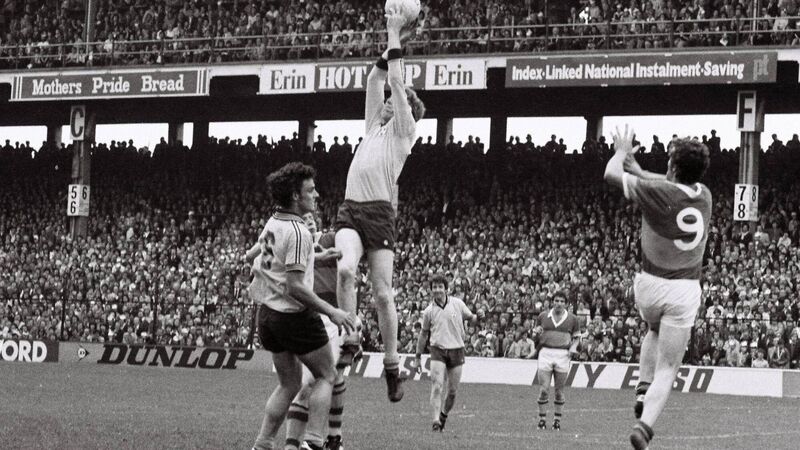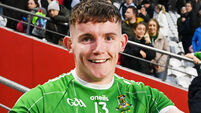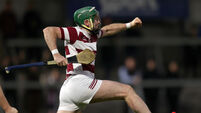Dublin v Kerry in '77: Is it the greatest game of Gaelic football ever played?

BLUE SKIES: Sean Doherty, Dublin, supported by team-mate Kevin Moran fields the ball under pressure from Kerry's Jack O'Shea. Picture: Connolly Collection / SPORTSFILE
It’s Sunday, 27 August 1977 and I’m standing on a seat in the old Cusack Stand in Croke Park. Dublin and Kerry are playing the All-Ireland senior football semi-final.
I’m a seven-year-old in short pants and a t-shirt. The sun is shining and am full of ice cream from Hughes Shop on Jones Road, which was owned by our cousins.
I’m in the stand with my father and two of my brothers. I’m standing on the seat because all around me everyone is standing too.
There’s only a couple of minutes left in an incredible match. I love football, spend all my time playing it or going to matches with my father. I know enough about it to understand that what is happening out on the pitch in front of me is different to any other match I’d been at.
In my mind’s eye, I can look back almost 50 years and see the fragments reform. I see Kevin Moran tearing through the Kerry defence. I see Brian Mullins everywhere. I see Mikey Sheehy soloing the ball in his own time, with extraordinary grace.
The whole thing is electric. Every score is celebrated like it is the most important thing that has ever happened.
Because for that moment that’s exactly what it was.
I remember people going wild all around me and just being in awe of it. There is nothing quite like the noise and clamour of a crowd at a raw tempest of a match.
All told, for everything that happened, it is one of the most vivid memories of my childhood.
Going back to look at this semi-final for ‘The Madness of Football’ series of podcasts was a really interesting thing to do.
The full game is there on YouTube and before starting I knew it could not possibly live up to the glory of a childhood memory.
In general, there is nothing like going back and watching a match that has lived on in your memory to strip it of much of what you believed to have happened it – and of the illusions of quality that it held.
There are two things to consider here: the first relates to nostalgia. Our sporting lives are drenched from top to toe in nostalgia. Old jerseys and old photos can spur the recall of a past sporting experience – whether as a player or a spectator – that holds a power to draw us back in time and evoke feelings of love and loyalty to a team or a moment or a place.
The term ‘nostalgia’ was first coined at the end of the seventeenth century by a physician who used it to denote a neurological condition among soldiers who were fighting in places far removed from their homes. It basically was an extreme form of homesickness, in which memories of home are almost only pleasant and positive. In time, of course, the idea of nostalgia spread into wider usage and it is now a word that is found well beyond a medical context.
At its core, nostalgia is about affectionate remembrance of the past – it is memory with the painful and disappointing bits taken out.
Any fear that nostalgia had warped a fair recollection of this match was quickly dispelled.
This match was compelling from beginning to end. In short, it is a remarkable game of football.
Is it the greatest game of Gaelic football ever played? That is a question that is impossible to answer, of course, but that it should be asked at all tells you everything about that semi-final.
I have a copy of the ‘Gaelic Sport’ magazine from December 1977. It has an article in it written by Eamonn Young who used that great semi-final to examine the way that Gaelic football had evolved over the decades.
His analysis of why Dublin eventually won was clear. He praised Kerry for their skills, their tackling, their movement and their intelligence. He noted, though, that Dublin were able to match them in all attributes and eventually won because they had the greater physical strength.
He wrote: ”Big able men full of spirit and power in a blue shirt, grabbed possession, low and high, before bursting through for scores at the Railway End.”
It was this end-game which has coloured most memories of the final. Kerry were brilliant, but they wilted. It was to be the last time for half-a-decade before this could be said again.
But, in truth, if you go back and watch the game again, you can see it with clarity. The physical exchanges around the field – but particularly in the middle – were ferocious. Dublin were the more seasoned team, right at the peak of their powers. Indeed, they never came to those heights again.
For their part, Kerry were still growing into themselves. It might rightly be said that they learned the lessons of that day and went on to become one of the greatest teams ever to play the game.
The last word can be left to Eamonn Young: “Gaelic football, like life, is ever changing. Men wore a different cut of clothes in every decade of the century and playing gear style went from the long togs to the tracksuits of today, which will in turn look corny to the men of 20 years hence.”
“All these are only the externals. Fundamentally, there is no great change in the men who wear the clothes and the same human attributes of brains, guts, skill and emotional control – put them in the order you desire – are still the essence of the winning team.”
*Paul Rouse is professor of history at University College Dublin.
Check out the entire podcast series HERE as, and when, they are published.














